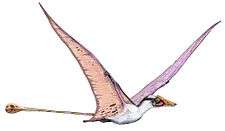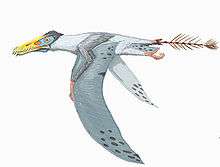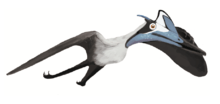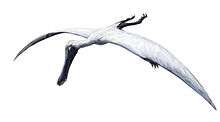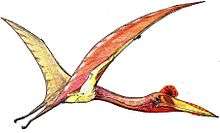Jeholopterus
Jeholopterus was a small anurognathid pterosaur from the Middle to Late Jurassic[1] Daohugou Beds of the Tiaojishan Formation of Inner Mongolia, China, preserved with hair-like pycnofibres and skin remains.
| Jeholopterus | |
|---|---|
 | |
| Skeletal reconstruction in the Rocky Mountain Dinosaur Resource Center, Woodland Park, Colorado | |
| Scientific classification | |
| Kingdom: | Animalia |
| Phylum: | Chordata |
| Order: | †Pterosauria |
| Family: | †Anurognathidae |
| Subfamily: | †Batrachognathinae |
| Genus: | †Jeholopterus Wang et al., 2002 |
| Type species | |
| †Jeholopterus ninchengensis Wang et al., 2002 | |
Naming
The genus was named in 2002 by Wang Xiaolin, Zhou Zhonghe and Xu Xing. The type species, the only known, is Jeholopterus ninchengensis. The genus name is derived from its place of discovery, Jehol in China, and a Latinised Greek pteron, "wing". The specific name refers to Nincheng County.
Description
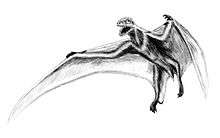
The type species is based on holotype IVPP V12705, a nearly complete specimen from the Daohugou beds of Ningcheng County in the Neimongol (Inner Mongolia) Autonomous Region of China.[2] The specimen is crushed into a slab and counterslab pair, so that parts of the specimen are preserved on one side of a split stone and some on the other. This includes exquisite preservation of carbonized skin fibers and pycnofibres. The fibers are preserved around the body of the specimen in a "halo." Wing tissue is preserved, though its extent is debatable, including the exact points of attachment to the legs (or if it is attached to the legs at all). In 2009 Alexander Kellner published a study reporting the presence of three layers of fibers in the wing, allowing the animal to precisely adapt the wing profile.[3]
As an anurognathid, Jeholopterus shows the skull form typical for this group, being wider than it was long (28 mm), with a very broad mouth. Most teeth are small and peg-like, but some are longer and recurved. The neck was short with seven or eight cervical vertebrae. Twelve or thirteen dorsal vertebrae are present and three sacrals. There are five pairs of belly ribs. The tail vertebrae have not been preserved. The describers argue that Jeholopterus had a short tail, a feature seen in other anurognathids but unusual for "rhamphorhynchoid" (i.e. basal) pterosaurs that typically have a long tail. Wang et al. cited the presence of a fringe of pycnofibres in the region of the tail to infer the presence of a short tail. However, a subsequent study by Dalla Vecchia argued that gleaning any information about the tail is impossible, given that the tail is "totally absent" in the fossil.[4]
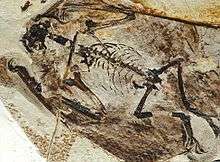
The wing bones are robust. The metacarpals are very short. A short pteroid, supporting a propatagium, is pointing towards the body. The hand claws are long and curved. The wings of Jeholopterus show evidence that they attached to the ankle, according to Wang et al.. They are relatively elongated with a wingspan of ninety centimetres.
The legs are short but robust. The toes bear well-developed curved claws, but these are not as long as the hand claws. The fifth toe is elongated, according to the authors supporting a membrane between the legs, the uropatagium.
Phylogeny
Jeholopterus was by the authors assigned to the Anurognathidae. An analysis by Lü Junchang in 2006 resolved its position as being the sister taxon of Batrachognathus. Kellner et al. 2009 proposed Batrachognathinae for the clade comprising these two genera and Dendrorhynchoides.[3]
Lifestyle
Anurognathids are normally considered insectivores. Wang e.a. hypothesised that Jeholopterus, being the largest species known of the group, might also have been a piscivore, a fish-eater.
In 2003, natural history writer David Peters, widely known for his highly inaccurate reconstructions and theories about most vertebrates, proposed Jehelopterus to be a hematophagic animal akin to a vampire bat[5]. This theory has been widely condemned and ridiculed by the palaeontological community[6][7].
References
- Gao, K. -Q.; Shubin, N. H. (2012). "Late Jurassic salamandroid from western Liaoning, China". Proceedings of the National Academy of Sciences. 109 (15): 5767–72. doi:10.1073/pnas.1009828109. PMC 3326464. PMID 22411790.
- Wang, X., Zhou, Z., Zhang, F., and Xu, X. (2002). "A nearly completely articulated rhamphorhynchoid pterosaur with exceptionally well-preserved wing membranes and 'hairs' from Inner Mongolia, northeast China." Chinese Science Bulletin 47(3), 226 – 232.
- Alexander W. A. Kellner, Xiaolin Wang, Helmut Tischlinger, Diogenes de Almeida Campos, David W. E. Hone, and Xi Meng. (2009). "The soft tissue of Jeholopterus (Pterosauria, Anurognathidae, Batrachognathinae) and the structure of the pterosaur wing membrane", Proc. R. Soc. B doi:10.1098/rspb.2009.0846
- Dalla Vecchia, F.M. (2002). "Observations on the non-pterodactyloid pterosaur Jeholopterus ningchengensis from the Early Cretaceous of Northeastern China." Natura Nascosta, 24: 8 - 27.
- Peters, David. "Papers". David Peters Studio. Retrieved May 18, 2020.
- Bennett, S. Christopher (February 2005). "Pterosaur Science or Pterosaur Fact" (PDF). Prehistoric Times. 70: 21–23, 40.
- Naish, Darren (July 3, 2012). "Why the world has to ignore ReptileEvolution.com". Scientific American. Retrieved May 18, 2020.
